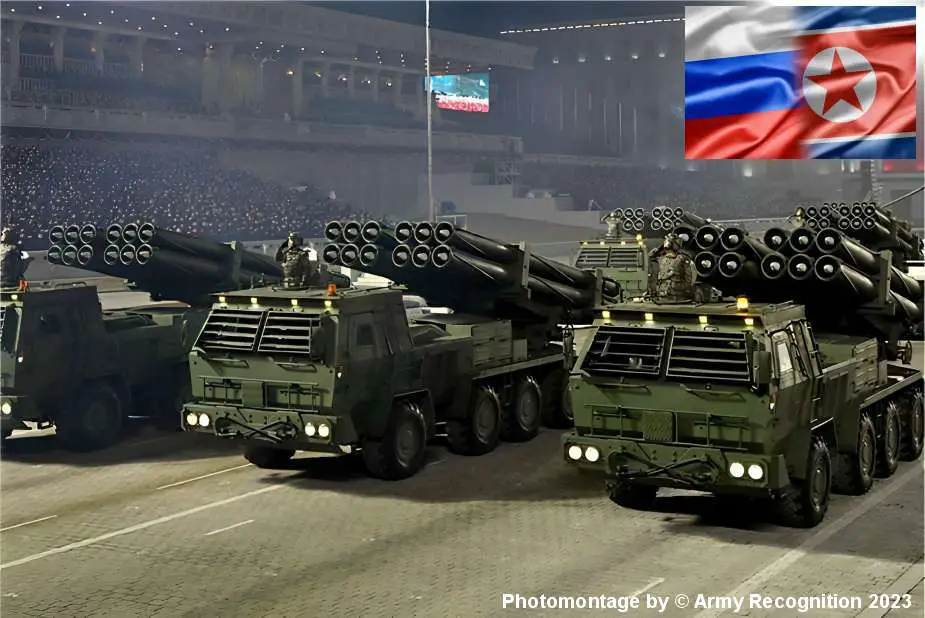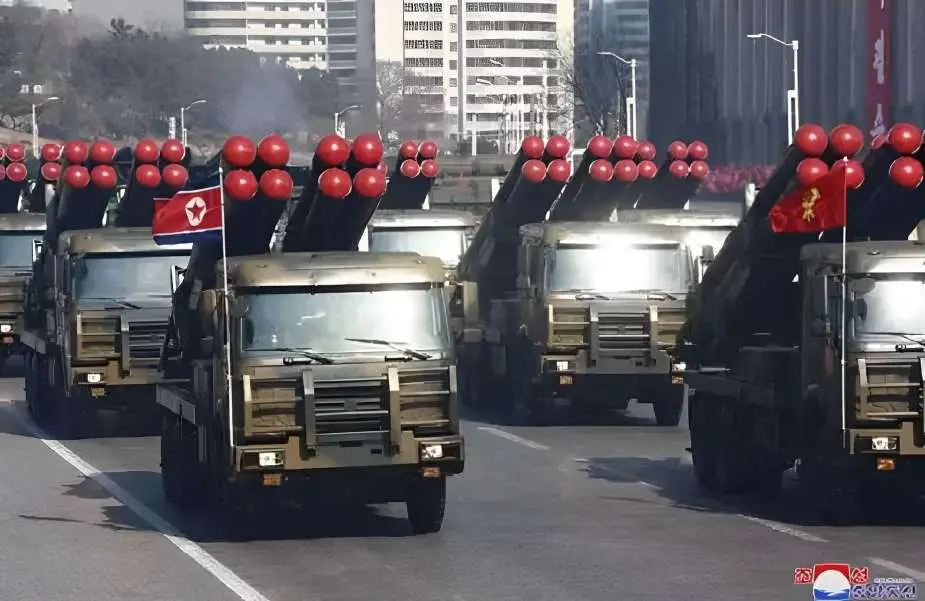- Army
- Conflicts in the world
- Israel - Iran conflict 2025
- Pakistan - India Conflict 2025
- Russia Ukraine War 2022
- Libya conflict day by day
- HAMAS - Israel War 2023
- Operation Serval in Mali French Army
- Sangaris operation Central African Republic
- Sangaris opération militaire République Centreafrique
- Ukraine - Russia conflict
- Syria conflict news
- Defence & Security Industry Technology
- Armies in the world
- Analysis Defense and Security Industry
- Conflicts in the world
- Navy
- Air
North Korea to supply MLRS and other missiles systems to Russia
Based on information circulating on Russian social media, the Democratic People's Republic of Korea (DPRK), commonly known as North Korea, is set to supply its KN-09 multiple-launch rocket systems (MLRS) to the Russian Federation. In addition to traditional artillery systems, North Korea has agreed to furnish Russia with missile systems. This development marks an enhancement in military cooperation between the two nations, granting Russia access to North Korean military equipment.
Follow Army Recognition on Google News at this link

North Korea to supply MLRS and other missile systems to Russia, including the modern ones (Picture source: KCNA)
The KN-09 rocket artillery system initially introduced around 2014, plays a pivotal role in this supply arrangement. Notably, it has a range of up to 220 kilometers and utilizes 300 mm caliber projectiles, making it a substantial addition to the Russian military's arsenal. Its capacity for multiple launches enhances its operational effectiveness.
Another component of this supply pact is the KN-25 system, unveiled by North Korea in 2019. The KN-25 is engineered to engage targets at ranges exceeding 400 kilometers, surpassing many comparable systems in terms of reach. It deploys six 600-mm caliber guided projectiles, each weighing three tons.
Moreover, there are reports suggesting that the supply agreement may also encompass the 170-mm M1989 Koksan self-propelled artillery mounts. These self-propelled guns can engage targets at distances of up to 40 kilometers using conventional ammunition and up to 60 kilometers when employing active-reactive projectiles.
According to sources, deliveries of these advanced military assets are slated to commence in October. This implies that the Russian Armed Forces may introduce these North Korean weapons into Ukraine by November.
The KN-09, also known as the North Korean 300 mm artillery rocket system, is a multiple-launch rocket system (MLRS) developed by North Korea. While the precise date of its deployment remains undisclosed, it is believed to have become operational in the 2010s. Typically, it is operated by a crew of approximately five personnel.
Specific dimensions and weight details of the KN-09 are not publicly available. The system is equipped with 300 mm caliber rockets stored in eight launch tubes, with each rocket weighing around 800 kg and carrying an estimated 200 kg warhead. These rockets have an approximate firing range of 130 km, which may vary depending on the type of rocket used. The system can conduct a full salvo lasting approximately 45 seconds, with a reloading time of 15 to 20 minutes.
The KN-09 is propelled by a diesel engine, although detailed engine specifications remain undisclosed. It can achieve a maximum road speed of approximately 90 km/h and possesses an operational range of 800 to 1,000 km, allowing it to cover substantial distances. In terms of maneuverability, the system can handle gradients up to 60%, side slopes up to 30%, vertical steps of approximately 0.5 meters, trench widths of around 0.6 meters, and water obstacles with depths of roughly 0.8 meters.
The rockets utilized in the KN-09 are believed to be Chinese SY-300 artillery rockets, known for their range of up to 130 km. These rockets are equipped with inertial guidance systems, offering a level of accuracy within a range of up to 200 meters, with potential improvements to 50 meters when updated with Baidu satellite navigation system data. The warhead options for these rockets include High Explosive Fragmentation (HE-FRAG), cluster rockets with scatterable anti-tank or anti-personnel mines, and potentially chemical warheads.
The KN-09 is esteemed for its simplicity, reliability, cost-effectiveness, and ease of production compared to ballistic missiles. Additionally, the system presents challenges to intercept due to the concentrated volleys of artillery rockets. The launcher vehicle for the KN-09 is based on a Chinese HOWO heavy-duty commercial truck with a 6x6 configuration, adapted for military purposes to provide a level of cross-country mobility.
According to a tweet by Patricia Marins on September 15, 2023, North Korea is in a position to supply Russia with a significant quantity of military equipment, including artillery shells and other essential assets. The North Korean army possesses an arsenal of around 21,000 artillery pieces, with a focus on larger calibers like 152mm and 122mm, totaling approximately 8,500 units. Each artillery piece is expected to have a 45-day firing capacity, which could result in North Korea having an estimated stockpile of 27 million 122mm/152mm shells. It's plausible that North Korea may supply Russia with 10 million of these shells.
While some of the ammunition may be aged, it is comparable to the Soviet stockpile previously used by Russia. Additionally, North Korea can offer the PT-76/85 amphibious tank, which aligns with Russia's potential plans for an assault on the Kherson river bank. Russia has been testing the Pat-S project, an amphibious artillery system with a 152mm caliber, indicating demand for such equipment in the region.
Determining the exact stockpile of rockets in North Korea is challenging, but the nation employs around 3.5 million people in various industries, with a significant portion involved in arms manufacturing. Given North Korea's prolonged state of war and focus on its defense industry, it is reasonable to assume they have accumulated a substantial supply of various ammunition types.

The North Korean deal will include the KN-09 MLRS (Picture source: KCNA)


























